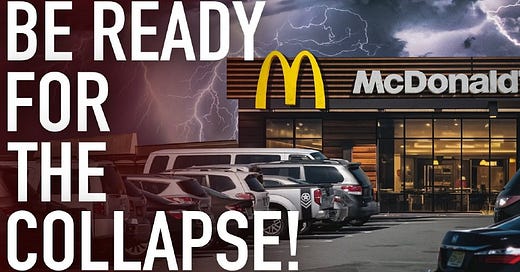McDonald's Bankruptcies Soar 40% and Now Thousands of Stores Are About to Disappear
Article and video by Epic Economist cross-posted with permission.
McDonald's is a fast food empire with over 40,000 restaurants across the globe and more than 13,000 locations in the United States. With an annual revenue of over $23 billion a year, the company is by far the largest burger chain in the world.
Since the pandemic, it saw profits ballooning, despite citing rising operational costs and supply chain issues as major problems dragging growth and even passing along a series of price increases to its customers to allegedly offset sales losses. With its stock rallying at the moment, and higher menu prices resulting in a significant increase in average ticket costs, it’s hard to imagine how a business of this size and magnitude can be struggling right now.
The answer is not simple, but in today’s video, we’re going to explain why the biggest fast food chain in the entire industry is facing a rare and yet unsurprising wave of bankruptcies in 2023.
Despite being the greatest fast-food corporation the world has ever seen, 95% of McDonald’s restaurants in America are operated by independent owners, and the war between corporate and franchisees seems to be getting worse this year. For decades, operators have been fighting McDonald’s tightening rules and expensive demands, and now many of them are hitting a breaking point.
For about 40% of franchisees, McDonald’s new financial requirements may end their years-long leases because the company’s rising expenses are not allowing these stores to hit profit targets. Simply put, these franchisees may have their contracts canceled, losing all of their investment if they fail to meet corporate expectations. In other words, one in four McDonald’s operators is at risk of going bankrupt due to the actions of the company itself.
But their strategy of expanding their business on the back of operators isn’t a clever one. At some point, its entire model could be at risk if enough of them decide to leave the company. When they signed their contracts with the megachain, franchisees were promised to become partners with the company. But over the years, corporate changed rules and regulations, so that the operators were the only ones responsible for the risk of managing a low-margin restaurant business during economic downturns.
On a consumer level, things aren’t going great either. The brand’s push for more expensive burgers has not been well-accepted by customers. Even though the average ticket prices have risen by roughly 15% over the past 12 months due to higher menu prices, there are fewer people visiting McDonald’s locations on a monthly basis, and they are even fewer people revisiting its restaurants multiple times in a month.
Put simply, customer loyalty is going down, and that was one of the main pillars that helped McDonald’s to build its brand since its foundation in 1955. Unfortunately, McDonald’s case is a clear demonstration of how a great business can rot from within due to its own greed. That’s a reality more people are waking up to right now, and that ultimately will contribute to the demise of the greatest fast-food chain America has ever seen.
Article and video cross-posted from Epic Economist.




We don’t eat McDonald’s but there is a location that we passed by almost every day anyway they were really busy before Covid sometime between the last 3 years they renovated the location and now that they back open they aren’t busy anymore.
We won’t miss the adrenachrome burgers.